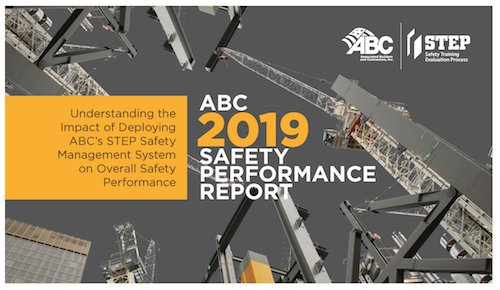ABC Report: Safety best practices can make construction companies 680% safer
2019 Safety Performance Report shows that proactive safety practices can reduce recordable incidents by up to 85%.
 ABC released its 2019 Safety Performance Report, an annual assessment that furthers the construction industry's understanding of how to achieve world-class safety through its STEP Safety Management System, in conjunction with Safety Week. The report documents the dramatic impact of using proactive safety practices to reduce recordable incidents by up to 85%, making the best-performing companies 680% safer than the industry average.
ABC released its 2019 Safety Performance Report, an annual assessment that furthers the construction industry's understanding of how to achieve world-class safety through its STEP Safety Management System, in conjunction with Safety Week. The report documents the dramatic impact of using proactive safety practices to reduce recordable incidents by up to 85%, making the best-performing companies 680% safer than the industry average.
Associated Builders and Contractors released its 2019 Safety Performance Report today, an annual assessment that furthers the construction industry’s understanding of how to achieve world-class safety through its STEP Safety Management System. Published in conjunction with Construction Safety Week, the report documents the dramatic impact of using proactive safety practices to reduce recordable incidents by up to 85%, making the best-performing companies 680% safer than the industry average.
“ABC’s fifth annual report on the use of leading indicators, such as substance abuse programs and toolbox safety talks, confirms that high-performing ABC members have safer construction jobsites,” said Greg Sizemore, ABC vice president of health, safety, environment and workforce development. “This is one of the few studies of commercial and industrial construction firms doing real work on real projects, and it shows that implementing best practices can produce world-class construction safety programs.”
The Safety Performance Report is based on data gathered from ABC member companies recording just under one billion hours of work in construction, heavy construction, civil engineering and specialty trades. It tracked 35 data points from companies that deployed STEP in 2018 to determine the correlation between leading indicator use and lagging indicator performance, which is measured by the Total Recordable Incident Rate and Days Away and Restricted or Transferred rate.
Each of the data points was sorted using a statistically valid methodology developed by the U.S. Bureau of Labor Statistics for its annual Occupational Injuries and Illnesses Survey, and then combined to produce analyses of STEP company performance against BLS industry average incident rates.
Among the findings:
- Companies that attained the highest level of STEP performance—Diamond—reduced their TRIR 85% compared to the BLS industry average of 2.9 injuries/fatalities per 100 full-time employees.
- Among the eight core leading indicators that had the most dramatic impact on safety performance in 2018, daily toolbox safety talks were the most effective—reducing TRIR by 85% compared to monthly sessions.
- STEP participants with a robust substance abuse program/policy in place dramatically outperformed those with a weaker program, reducing their TRIR by 60%.
- A biannual review and evaluation of safety program performance by executive leadership led to a 59% reduction in TRIR.
- Analyzing and taking action on trailing indicators reduced TRIR by 57%.
Founded in 1989 as a safety benchmarking and improvement tool, STEP has evolved into a world-class safety management system that demonstrates safety leadership and cultural transformation to clients. Participating ABC member firms measure their safety processes and policies on 20 key components through a detailed questionnaire with the goal of implementing or enhancing safety programs that reduce jobsite incidence. Applying world-class processes dramatically improves safety performance among participants regardless of company size or type of work.
May 6-10 is Construction Safety Week, a national, industry-wide effort to promote safety best practices and raise awareness of the importance of an uncompromising commitment to safety in the construction industry.
Read the report at abc.org/spr.
















